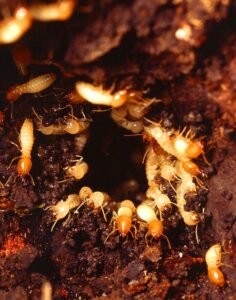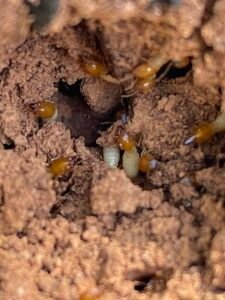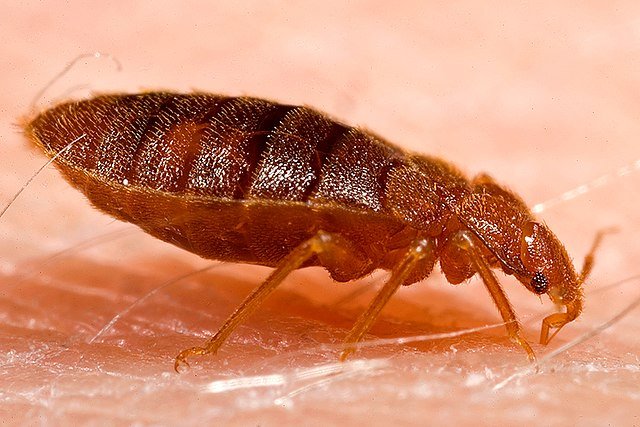Formosan Subterranean Termites: Identification, Biology, Damage, and Control
 The Formosan subterranean termite (Coptotermes formosanus) is often called the “super termite” due to its aggressive feeding habits and enormous colony size. Originally from southern China and Taiwan (historically known as Formosa, hence the name), this species has become one of the most destructive structural pests worldwide. Unlike drywood termites or dampwood termites, Formosan subterranean termites require constant contact with soil or moisture sources, but their ability to build vast underground networks makes them exceptionally difficult to eliminate.
The Formosan subterranean termite (Coptotermes formosanus) is often called the “super termite” due to its aggressive feeding habits and enormous colony size. Originally from southern China and Taiwan (historically known as Formosa, hence the name), this species has become one of the most destructive structural pests worldwide. Unlike drywood termites or dampwood termites, Formosan subterranean termites require constant contact with soil or moisture sources, but their ability to build vast underground networks makes them exceptionally difficult to eliminate.
This article explores their biology, global spread, the severe risks they pose, and the strategies homeowners and professionals can use for long-term control.
Identification
Formosan subterranean termites can be mistaken for other termite species, but there are distinct traits:
Workers: Creamy white, soft-bodied, about 3–4 mm long.
Soldiers: Larger heads compared to native subterranean termites; tear-shaped heads with strong, curved mandibles. Soldiers account for a higher percentage of the colony (10–15%) than in other species.
Alates (swarmers): Pale brown to yellowish-brown, about 12–15 mm long with wings. They swarm at night, typically in late spring and early summer, attracted to lights.
Compared to subterranean termites (Reticulitermes spp.), Formosan subterranean termites are larger, more aggressive, and form colonies several times bigger.
Biology and Ecology
The colony structure of Coptotermes formosanus is highly organized:
Queen and King: Responsible for reproduction. The queen can lay thousands of eggs daily.
Workers: Maintain tunnels, care for eggs, feed the colony.
Soldiers: Defend the colony with their large mandibles and a sticky defensive secretion.
Alates: Winged reproductives that establish new colonies after swarming events.
Nesting Behavior
 Unlike drywood termites, which live entirely inside wood, Formosan subterranean termites build extensive mud tubes from soil to reach food sources. Colonies can exceed 10 million individuals.
Unlike drywood termites, which live entirely inside wood, Formosan subterranean termites build extensive mud tubes from soil to reach food sources. Colonies can exceed 10 million individuals.
Feeding Habits
They consume cellulose, breaking it down with the help of gut protozoa and bacteria. Beyond wood, they may chew through plastic, rubber, and even thin copper or lead sheeting in search of food and moisture.
Global Distribution
Native to China and Taiwan, Formosan subterranean termites have spread globally:
United States: Established in the southern states, particularly Louisiana, Texas, Florida, Georgia, and South Carolina. New Orleans is a well-documented hotspot.
Asia: Found across Japan, Hong Kong, and parts of Southeast Asia.
Pacific Islands: Infestations reported in Hawaii and Guam.
Other regions: Sporadic but concerning appearances in Africa and the Caribbean.
Their spread is often linked to human trade, especially timber and shipping routes.
Risks and Damage
Formosan subterranean termites are among the most destructive pests in the world:
Structural damage: They hollow out wood, leaving only a thin veneer, making homes unsafe.
Economic costs: In the U.S. alone, they cause over $1 billion in damages and control expenses annually.
Speed of destruction: A large colony can consume nearly a foot-long 2x4 piece of wood in 25 days.
Wider threats: They damage utility poles, boats, furniture, and even living trees.
Unlike carpenter ants, which only excavate wood for nesting, termites actively eat the cellulose, causing far greater losses.
Signs of Infestation
Detecting Formosan subterranean termites early is difficult but crucial:
Mud tubes on walls, foundations, or crawl spaces.
Hollow-sounding wood that breaks easily.
Swarmers flying around lights during spring and early summer evenings.
Discarded wings near windows or doors.
Frass (droppings), though less obvious than in drywood termites.
Sagging floors or ceilings due to internal wood loss.
Because their colonies are massive, visible damage often means the infestation is already advanced.
Control Methods
Inspection
Regular professional inspections in high-risk areas (warm, humid climates).
Use of moisture meters and acoustic devices for hidden colonies.
Physical Barriers
Stainless steel mesh or sand barriers around foundations during construction.
Sealing cracks, holes, and utility entry points.
Chemical Control
Soil treatments with non-repellent termiticides such as fipronil or imidacloprid.
Wood treatments with borates to prevent feeding.
Baiting Systems
Termite baits with insect growth regulators (IGRs) like hexaflumuron or noviflumuron.
Baits are especially effective for large colonies since termites spread the toxin socially.
Moisture Management
Fix leaks in plumbing, gutters, and roofs.
Ensure proper drainage around foundations.
Advanced Approaches
Modern termite management goes beyond traditional chemicals:
Infrared imaging for non-invasive detection of termite activity.
Biological control: Research into nematodes and fungi that target termite colonies.
RNA interference (RNAi): An experimental technique to disrupt termite gene expression.
Integrated Pest Management (IPM): Combining monitoring, prevention, baiting, and limited chemical use.
Cultural and Historical Context
Formosan subterranean termites have shaped pest management and urban history:
New Orleans case: After Hurricane Katrina (2005), damaged wood structures provided an ideal breeding ground. The city now invests heavily in monitoring and baiting programs.
Hawaiian architecture: Traditional wooden homes had to adapt with termite-resistant materials due to repeated infestations.
Trade and shipping: Their spread mirrors globalization, making them a symbol of how pests move with human commerce.
In contrast, other species like the roof rat (Rattus rattus) historically spread the bubonic plague. Termites, instead, changed the economics of construction and maintenance in tropical and subtropical regions.
Frequently Asked Questions (FAQ)
Q1: How big can a Formosan termite colony get?
A single colony can exceed 10 million individuals, much larger than native subterranean termite colonies.
Q2: Are Formosan termites more dangerous than drywood termites?
Yes. Drywood termites cause localized damage, while Formosan termites can destroy entire structures due to colony size and aggressive feeding.
Q3: When do Formosan termites swarm?
They typically swarm at night in late spring and early summer, often after rain.
Q4: Can they chew through concrete?
They cannot eat concrete, but they can squeeze through cracks as thin as 1.5 mm to reach wood.
Q5: What is the best treatment for Formosan termites?
Baiting systems combined with soil treatments and moisture control are the most effective long-term strategies.
Q6: How do Formosan termites spread?
Primarily through swarming alates, but human trade (shipping and lumber transport) has expanded their global presence.
Final Thoughts
The Formosan subterranean termite (Coptotermes formosanus) is one of the most destructive pests in the world. Its vast colonies, ability to chew through structures rapidly, and resilience against traditional treatments make it a major threat to homes, businesses, and infrastructure. Unlike drywood termites or dampwood termites, Formosan termites are highly invasive, spreading through global trade and establishing themselves in warm, humid regions across multiple continents.
Homeowners should remain vigilant for early warning signs such as mud tubes, discarded wings, and hollow wood. Once an infestation is established, DIY methods are rarely sufficient. The most effective approach is Integrated Pest Management (IPM), which combines moisture reduction, physical barriers, baits, and professional treatments.
History shows us that these termites are not just a nuisance but a global economic and urban challenge, shaping how societies build and protect structures. Being proactive in inspection and prevention is the best defense against their costly destruction.
Disclaimer
This article is for informational purposes only. Pest control laws and approved chemicals vary by country. For best results and legal safety, we strongly recommend contacting a licensed pest control professional in your local area. Always make sure that the pest control technician is properly certified or licensed, depending on your country’s regulations. It’s important to confirm that they only use approved products and apply them exactly as instructed on the product label. In most places in Europe, UK, or USA, following label directions is not just best practice—it’s the law.
Author Bio
Nasos Iliopoulos, BSc Agronomist & Certified Pest Control Expert
Scientific Director – Advance Services (Athens, Greece)
Licensed Pest Control Business – Ministry of Rural Development & Food (GR)
References
Oxford Univeristy Press - Behavioral and Histological Changes in the Formosan Subterranean Termite (Isoptera: Rhinotermitidae) Induced by the Chitin Synthesis Inhibitor Noviflumuron
Wikipedia - Formosan subterranean termite
- 533–542.

